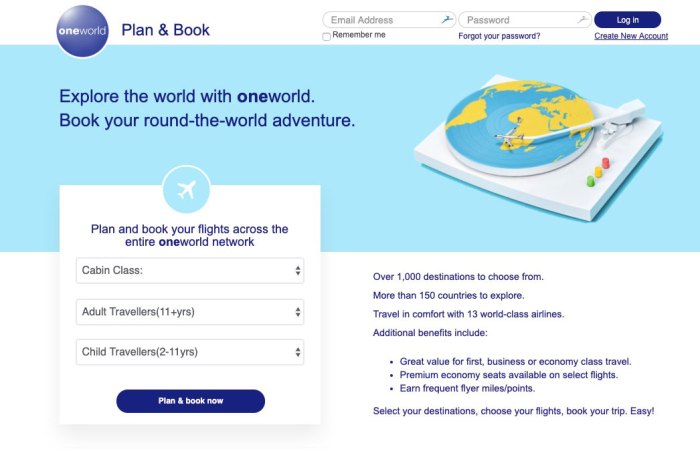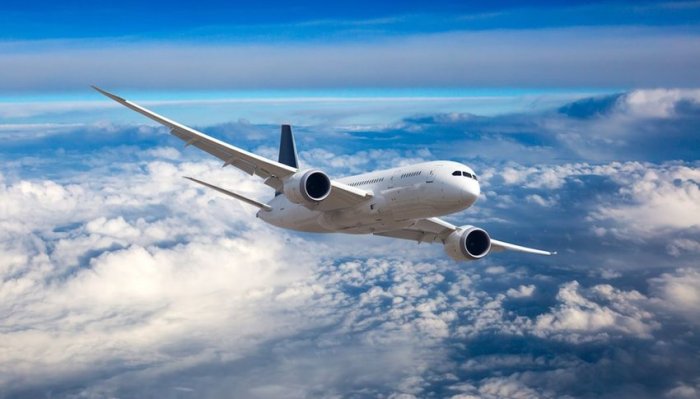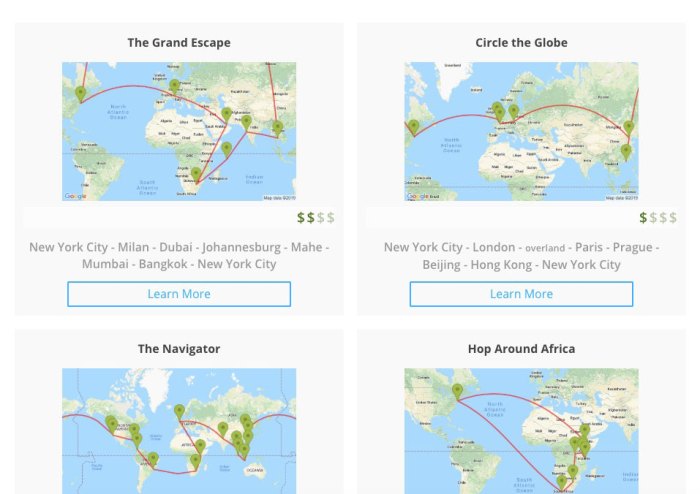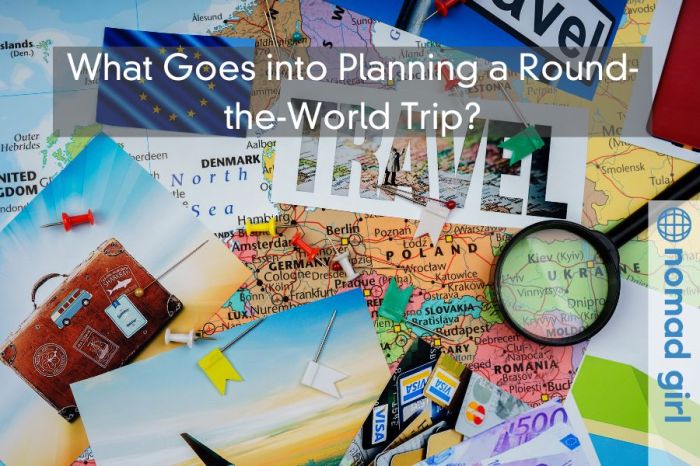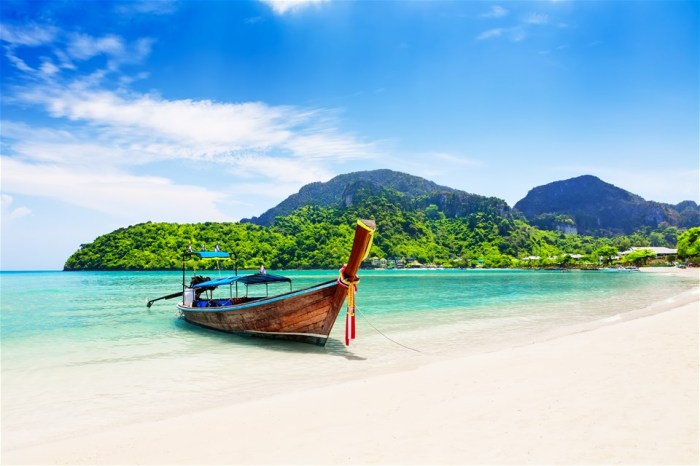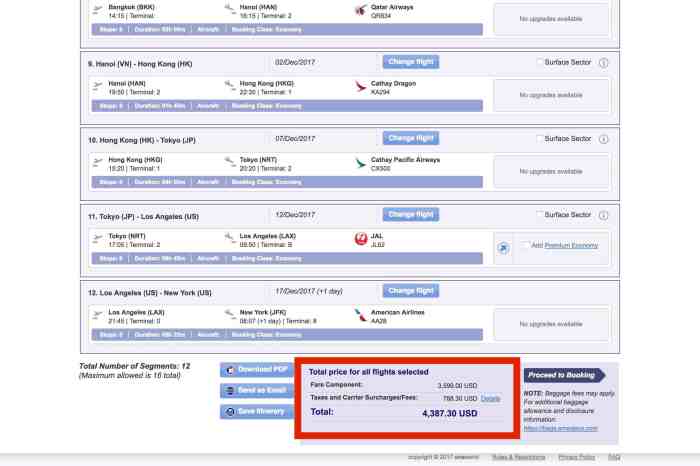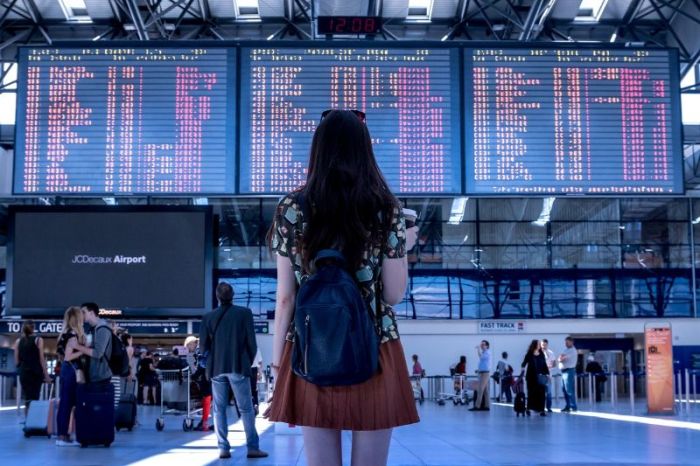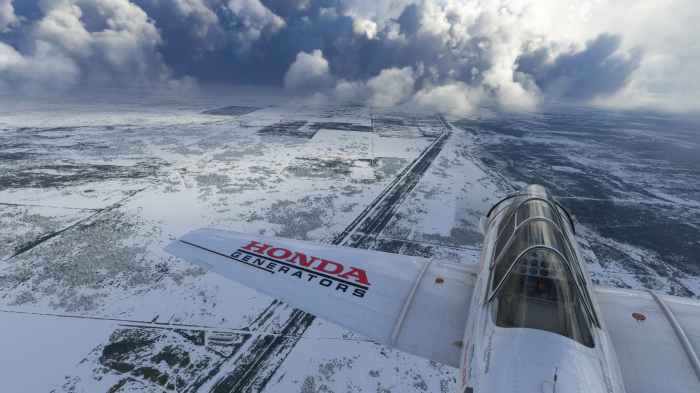Round the world trip budget is the cornerstone of any epic journey. This comprehensive guide breaks down the complexities of planning a global adventure, ensuring you have a realistic and well-informed strategy. From meticulous itinerary planning to savvy savings strategies, we explore all facets of budgeting for this incredible expedition.
This exploration delves into crucial aspects of crafting a successful budget for a round-the-world adventure, considering factors like transportation, accommodation, food, and activities. We will analyze various trip styles, providing detailed insights into managing costs effectively in different regions and during varying seasons.
Defining the Budget

Source: rtwin30days.com
A round-the-world trip, a dream for many, necessitates meticulous budgeting. This isn’t just about saving; it’s about crafting an experience that aligns with your aspirations and financial capacity. Understanding the variables influencing cost is crucial for creating a realistic and enjoyable journey.Careful consideration of various factors like travel style, destination choices, and desired level of luxury directly impacts the overall expenditure.
The budget is a dynamic entity that reflects the interplay of these factors, demanding careful evaluation and strategic planning to achieve a fulfilling journey.
Factors Influencing Round-the-World Trip Budget
Several elements contribute to the cost of a circumnavigation. Travel style, the duration of the trip, and the specific destinations chosen all play a pivotal role. The level of comfort and luxury desired will significantly impact the budget. For instance, a trip focusing on budget-friendly hostels and local cuisine will be considerably cheaper than one that prioritizes five-star hotels and gourmet meals.
Different Trip Styles and Budget Considerations
Various trip styles cater to diverse preferences and budgets. A backpacking trip, emphasizing affordability, typically involves budget airlines, hostels, and local transport. A more luxurious journey might encompass first-class flights, five-star hotels, and guided tours. Each style dictates different expenditure patterns.
Luxury vs. Budget Round-the-World Trip
The difference between a luxury and a budget trip is stark. Luxury trips involve premium accommodations, private transportation, and extravagant experiences like Michelin-star dining and exclusive tours. Budget trips, conversely, rely on budget airlines, hostels, public transport, and local eateries. This difference in approach directly impacts daily spending.
Typical Daily Spending Examples
Daily spending varies drastically depending on the chosen style and location. A budget traveler in Southeast Asia might spend $20-$50 per day, covering basic accommodations, food, and transport. In contrast, a luxury traveler in Europe could easily spend $200-$500 per day on high-end hotels, gourmet meals, and premium activities.
Crafting a round-the-world trip budget requires meticulous planning, especially when considering the significant costs of airfare. Securing the best deals on world tour flights is crucial to keeping the overall trip budget manageable. Factors like routing, booking windows, and airline partnerships heavily influence the final price, making savvy flight selection a key element in achieving a successful and affordable global adventure.
Budget vs. Luxury Trip Comparison, Round the world trip budget
| Category | Budget Trip (Example: Southeast Asia) | Luxury Trip (Example: Europe) |
|---|---|---|
| Flights | $100-$300 per flight segment | $500-$1500 per flight segment |
| Accommodation | $10-$30 per night (hostel) | $200-$500 per night (luxury hotel) |
| Activities | $10-$50 per activity | $50-$500 per activity (guided tours, Michelin-star dining) |
| Food | $10-$25 per day (local cuisine) | $50-$150 per day (gourmet meals) |
This table illustrates the considerable cost difference between a budget and a luxury round-the-world trip, highlighting the impact of various factors on the overall expenditure.
Trip Planning and Cost Estimation: Round The World Trip Budget
A well-defined itinerary is crucial for managing a global journey’s budget. Precise planning allows for realistic cost estimations, enabling informed decisions regarding spending and resource allocation. Understanding how costs fluctuate across different regions and travel seasons is paramount for optimizing expenditure. A detailed approach to estimating costs for transportation, accommodation, and activities ensures a smooth and financially manageable trip.
Planning a round-the-world trip demands a meticulous budget. While extensive global travel is appealing, exploring local backpacking trails near me, like those listed at backpacking trails near me , can offer incredible experiences without breaking the bank. This can provide valuable insights and contribute to a more comprehensive budget for the ultimate round-the-world adventure.
Importance of a Detailed Itinerary
A comprehensive itinerary acts as a roadmap, outlining destinations, activities, and estimated durations. This structured approach allows for a clearer picture of travel time, potential delays, and associated costs. Detailed planning minimizes the risk of unexpected expenses, facilitating a more controlled and efficient use of funds. It enables adjustments to the budget and reallocation of resources based on evolving circumstances.
For instance, a detailed itinerary might incorporate flexible options for activities, allowing for budget adjustments based on prevailing prices or personal preferences.
Methods for Estimating Costs
Estimating costs for different regions involves examining historical data, consulting travel guides, and researching online platforms. Analyzing average prices for accommodations, transportation, and activities in various locations is essential. Furthermore, factoring in potential fluctuations in costs due to seasonal variations or special events is critical. Local travel agencies and tour operators can provide valuable insights into current market prices and potential cost-saving strategies.
Sample Itinerary with Estimated Costs
A sample itinerary for a 30-day trip across Southeast Asia, focusing on Thailand, Vietnam, and Cambodia, demonstrates the process.
- Thailand (10 days): Flights (estimated $800), accommodation (estimated $300), activities (estimated $200), food (estimated $300). Total estimated cost: $1600.
- Vietnam (10 days): Flights (estimated $600), accommodation (estimated $300), activities (estimated $250), food (estimated $350). Total estimated cost: $1550.
- Cambodia (10 days): Flights (estimated $500), accommodation (estimated $300), activities (estimated $200), food (estimated $300). Total estimated cost: $1300.
This example demonstrates a simplified approach, and actual costs may vary depending on specific choices and travel dates.
Step-by-Step Guide to Budget Estimation
This step-by-step approach to estimating travel costs is crucial:
- Define destinations and travel duration: Clearly Artikel the destinations and the timeframe for the trip.
- Research transportation costs: Compare airfare, train tickets, and other transportation options between destinations.
- Estimate accommodation costs: Look into various accommodation types (hostels, hotels, guesthouses) and their associated prices.
- Identify and estimate activity costs: Consider activities like tours, entrance fees, and entertainment.
- Calculate food costs: Determine the average daily food budget based on local prices and preferences.
- Factor in potential expenses: Account for potential expenses like visa fees, travel insurance, and personal items.
- Adjust for peak/off-season variations: Consider how costs might differ during peak and off-season travel periods.
Cost Variations by Season
| Item | Peak Season | Off-Season |
|---|---|---|
| Flights | Higher | Lower |
| Accommodation | Higher | Lower |
| Activities | Potentially higher | Potentially lower |
| Food | Potential price fluctuations | Lower or consistent |
The table illustrates how costs for transportation, accommodation, activities, and food can fluctuate between peak and off-season periods. This insight enables travelers to strategically time their trips to maximize cost-effectiveness.
Transportation Costs
Global travel often hinges on the cost-effectiveness of transportation. Choosing the right mode, from budget-friendly buses to high-speed trains, significantly impacts a trip’s overall budget. This section details the factors affecting transportation costs and strategies for optimizing travel expenditures.
Flight Costs and Strategies
Finding affordable flights is crucial for any round-the-world journey. Flexibility in travel dates and times, as well as utilizing flight comparison websites, are key strategies. Booking in advance can often lead to substantial savings, especially for popular routes and peak travel seasons.
- Flexibility is Key: Adjusting your travel dates by a day or two can sometimes yield significant discounts. Consider flying on weekdays, when fares are often lower, or during the shoulder seasons instead of peak travel periods.
- Comparison Tools are Essential: Utilize flight comparison websites to compare prices from different airlines and travel agencies. These platforms allow you to filter by specific dates, destinations, and other criteria, enabling you to identify the most economical options.
- Strategic Booking: Book flights in advance, especially for longer-haul destinations. This often results in better deals, allowing you to allocate your budget effectively.
Train Travel Costs Across Continents
Train travel offers a unique and often scenic way to explore various destinations. However, costs can vary significantly across continents. Europe, known for its extensive and efficient rail network, generally offers competitive fares compared to other continents.
- Europe’s Extensive Network: Europe’s high-speed rail system, such as the Eurostar, allows for efficient and often cost-effective travel between major cities. Consider purchasing a rail pass if you plan to travel extensively within the region.
- Asia’s Diverse Rail Systems: Asia’s rail networks, while extensive in some regions, can vary significantly in cost and efficiency. Japan’s Shinkansen is renowned for its speed and comfort, but fares can be substantial. Consider local trains and buses for more affordable travel within Asia.
- North America’s Rail Options: North America’s rail travel options are often more expensive than Europe’s, with a smaller network and higher ticket prices. The Amtrak system offers a slower, more scenic alternative, but costs may be higher than flying.
Bus and Ferry Travel
Buses and ferries offer budget-friendly alternatives for inter-city travel. These modes are ideal for budget travelers and those prioritizing scenic routes. However, travel times may be longer than other options.
Planning a round-the-world trip requires careful budgeting. Understanding fluctuating costs, from flights to accommodation, is crucial. A key element in managing such an extensive trip is researching and comparing various travel options, like those found at Travel , to get a realistic picture of costs. Ultimately, a well-structured budget is essential for a successful global adventure.
- Cost-Effectiveness: Buses and ferries are generally more affordable than flights or trains, making them a practical choice for budget-conscious travelers.
- Travel Time Considerations: Travel times by bus and ferry can be considerably longer than other options, so factor this into your trip planning.
- Scenic Advantages: Buses and ferries often provide unique scenic opportunities, offering a different perspective on the landscapes and local culture.
Average Flight Costs (Illustrative Table)
This table provides an illustrative example of average flight costs between major cities, recognizing that costs can fluctuate based on several factors.
| Region | City A | City B | Average Flight Cost (USD) |
|---|---|---|---|
| North America | New York | Los Angeles | $300 – $500 |
| Europe | London | Paris | $150 – $300 |
| Asia | Tokyo | Singapore | $400 – $800 |
Accommodation Costs
Global travel necessitates careful consideration of accommodation expenses. Choosing the right lodging can significantly impact a trip’s budget, and savvy travelers optimize their options for cost-effectiveness. Strategic selection and comparison of various accommodation types are essential for a successful budget.
Different Accommodation Options and Their Costs
Accommodation choices span a spectrum, from budget-friendly hostels to luxury resorts. Understanding the price points associated with each type empowers travelers to make informed decisions aligned with their financial goals. The costs vary considerably based on location, season, and demand.
Affordable Accommodation Options
Hostels and guesthouses represent attractive options for budget-conscious travelers. These lodgings often offer social interaction and shared spaces, contributing to a more immersive travel experience. Finding affordable options requires proactive research, utilizing online travel platforms and local recommendations. Websites like Hostelworld and Booking.com frequently feature deals and discounts, allowing travelers to discover economical stays.
Comparison of Accommodation Choices
Hotels, Airbnb, and other options each present distinct advantages and disadvantages. Hotels provide established amenities and service, while Airbnb offers more personalized experiences. However, hotels often command higher rates compared to Airbnb, particularly in popular tourist destinations. Other options, such as vacation rentals, can be cost-effective for larger groups or families, but may require careful scrutiny of hidden costs.
Long-Term Stays vs. Shorter Stays
Long-term stays can be more economical than a series of shorter stays, especially in areas with fluctuating prices. However, shorter stays often offer more flexibility and spontaneity. Travelers should weigh the benefits of longer stays against the advantages of shorter, more frequent trips. For example, a month-long stay in a European city might be cheaper than multiple weekend trips, but might also limit spontaneity.
Price Range Comparison
A comparative analysis of accommodation costs across various categories provides a clear picture of budget considerations. The table below illustrates the approximate price ranges for budget-friendly hostels, mid-range hotels, and luxury resorts, offering a framework for budgeting.
| Accommodation Type | Approximate Price Range (per night) |
|---|---|
| Budget-Friendly Hostels | $10-$50 |
| Mid-Range Hotels | $50-$200 |
| Luxury Resorts | $200+ |
Food and Activities
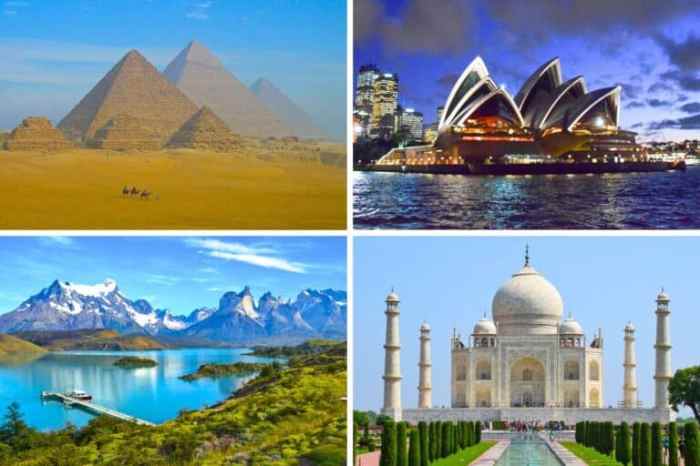
Source: rtwin30days.com
Global culinary experiences are a cornerstone of any world journey. Budgeting for food and activities requires a nuanced approach, factoring in diverse local costs and personal preferences. Careful planning can transform seemingly daunting expenses into enriching discoveries.Food costs fluctuate significantly across nations, with certain regions offering substantial savings compared to others. Understanding these variations and adopting economical eating strategies are essential for maximizing your trip’s value.
Activities, whether cultural immersion or adrenaline-fueled adventures, also contribute to the overall budget, demanding a balanced perspective between experience and affordability.
Food Costs in Different Countries
Food expenses vary considerably by region. European nations, while offering rich culinary traditions, typically have higher food costs compared to parts of Asia or South America. For example, a simple meal in a mid-range restaurant in France might cost significantly more than an equivalent meal in Thailand. The cost of fresh produce and staples also differs considerably between regions.
Factors like local agricultural practices, import costs, and seasonal availability all contribute to price variations.
Eating Cheaply and Enjoying Local Cuisine
Exploring local markets is often the most economical way to experience authentic cuisine. These markets provide access to fresh, local produce and ingredients at significantly lower prices than restaurants. Street food vendors also offer affordable and flavorful options, providing a taste of regional specialties. Another strategy involves preparing some meals in your accommodation or utilizing budget-friendly cooking facilities, if available.
This not only saves money but also provides a chance to engage with local cooking methods and flavors.
Budgeting for Activities and Attractions
Developing a detailed itinerary for activities, including research into pricing and potential discounts, is crucial for effective budgeting. Many tourist attractions offer bundled packages or combination tickets that can lower costs. Consider exploring free or low-cost activities like walking tours, parks, or museums with free admission days. Utilizing public transportation or walking whenever possible also reduces transportation costs, allowing for better exploration.
Budget-Friendly Activities in Different Locations
- Europe: Explore historic cities on foot, visit free museums on designated days, or take advantage of walking tours. Consider picnics in parks as an economical alternative to expensive restaurants.
- Southeast Asia: Engage in cultural experiences such as cooking classes, temple visits (often free or low-cost), and attend local festivals.
- South America: Hike in national parks, visit local markets for souvenirs, and participate in affordable outdoor activities like surfing or horseback riding.
Dining Costs in Different Types of Restaurants and Cafes
- Street Food: Extremely budget-friendly, offering a taste of local cuisine at very low prices. Street vendors in many countries are a great option for quick and affordable meals.
- Local Cafes: Often provide a more affordable alternative to sit-down restaurants, serving simple and delicious local meals at moderate prices. They are usually great options for lunch or breakfast.
- Mid-range Restaurants: These restaurants often offer a balance between quality and affordability, providing a wider selection of dishes at a reasonable price point. This category offers a better experience than street food, while still keeping costs manageable.
- High-end Restaurants: These restaurants are associated with higher costs, offering a premium dining experience with exquisite cuisine and often luxurious ambiance. Their pricing reflects the quality of ingredients and service.
Currency Exchange and Financial Management
Navigating global currencies and managing finances effectively is crucial for a smooth and budget-conscious round-the-world trip. Fluctuations in exchange rates and unexpected expenses can quickly impact your overall trip cost. Thorough planning and financial strategies are essential to mitigate these risks and ensure a satisfying experience.Effective financial management during a world trip requires a proactive approach to currency exchange and expenditure.
This includes understanding the potential impact of currency fluctuations on your budget, adopting appropriate strategies for managing funds, and choosing suitable tools for tracking expenses. A well-structured financial plan can significantly reduce stress and enhance the enjoyment of your adventure.
Importance of Currency Exchange
Exchange rate variations directly affect the value of your spending money in different countries. A strong home currency against a destination’s currency can make your trip more affordable, while a weak home currency can increase costs. This necessitates a careful consideration of exchange rates during the planning stages. Monitoring the currency market and planning your expenditure accordingly is essential for maintaining a healthy budget.
Strategies for Managing Finances
Utilizing budgeting apps and tools offers a convenient method for tracking expenses, setting financial limits, and monitoring spending patterns. These applications provide a detailed overview of your financial situation, aiding in informed decision-making and ensuring adherence to your budget. Many apps allow you to create separate categories for various expenses, helping you stay on track and identify areas where you might be overspending.
Different Options for Managing and Exchanging Money
Several options exist for managing and exchanging money. Pre-paid travel cards provide a secure way to store and spend money internationally. They often offer competitive exchange rates and allow you to load funds directly into your account. Credit cards with favorable foreign transaction fees can also be beneficial. However, using them extensively may accumulate significant interest charges, especially if not managed carefully.
Checking with your bank about international transaction fees and exchange rates is crucial to ensure you are aware of any potential costs.
Opening a Local Bank Account Abroad
Opening a local bank account in the destination country allows you to access banking services locally and can be advantageous. It can reduce international transaction fees and provide access to local ATMs, potentially offering more favorable exchange rates than traditional methods. Researching the procedures and requirements for opening a foreign bank account in advance is crucial to avoid any delays or complications.
Be prepared to provide documentation such as identification and proof of residency.
Typical Exchange Rates
| Currency | Exchange Rate (USD) |
|---|---|
| Euro (EUR) | 1.00 USD = 0.95 EUR (Example) |
| British Pound (GBP) | 1.00 USD = 0.75 GBP (Example) |
| Japanese Yen (JPY) | 1.00 USD = 140 JPY (Example) |
| Canadian Dollar (CAD) | 1.00 USD = 1.35 CAD (Example) |
| Australian Dollar (AUD) | 1.00 USD = 1.40 AUD (Example) |
Note: Exchange rates are constantly changing. These are examples and should not be considered definitive values. Consult current exchange rate resources for precise values before making transactions.
Planning a round-the-world trip requires careful budgeting. While extensive travel often involves significant costs, exploring local hiking trails like those near you can be a surprisingly affordable way to experience the world. For example, checking out hiking trails in near me can provide a fantastic opportunity to test your budget for outdoor adventures, ultimately informing your round-the-world trip planning and potentially saving you money in the long run.
Savings and Budgeting Strategies
A successful round-the-world trip hinges on meticulous planning and a well-defined budget. Effective savings strategies are crucial to securing the financial resources needed for this extensive journey. This involves more than just saving; it’s about establishing a disciplined approach to money management, ensuring sufficient funds are available to cover unforeseen circumstances and maintain a comfortable experience throughout the trip.Careful planning and budgeting are paramount to achieving financial stability for a globe-trotting adventure.
This involves anticipating and accounting for various expenses, from transportation and accommodation to food and activities. A well-structured savings plan allows for flexibility and adjustments based on the evolving needs of the journey.
Importance of Early Savings
Initiating a savings plan early is vital for a round-the-world trip. Accumulating funds gradually allows for the benefit of compounding interest, maximizing the return on investment over time. This approach minimizes the pressure of accumulating a large sum of money quickly and helps in maintaining a consistent saving pattern. For instance, starting a savings account specifically for the trip, and consistently contributing a fixed amount each month, ensures consistent progress towards the financial goal.
Savings Methods for a Round-the-World Trip
Numerous methods exist for saving money for an extended trip. These strategies range from simple budgeting techniques to more complex investment approaches. Employing a combination of methods can be particularly effective in achieving the desired savings goal. These methods include:
- Automated Savings: Setting up automatic transfers from your checking account to a dedicated savings account. This approach prevents impulsive spending and ensures consistent contributions to the travel fund.
- Budgeting and Tracking: Developing a detailed budget and meticulously tracking expenses to identify areas where savings can be achieved. This practice aids in identifying unnecessary spending and helps in formulating a realistic budget.
- Cutting Unnecessary Expenses: Identifying and eliminating non-essential expenses. This can range from reducing subscriptions to entertainment services to cooking more meals at home. These small, consistent adjustments add up over time.
- Side Hustles: Taking on part-time jobs or freelance work to supplement income. This can range from tutoring to online selling and other freelance work. The extra income significantly accelerates the savings process.
Creating a Realistic Budget
Developing a realistic budget for a round-the-world trip is essential for success. It involves accurately estimating expenses for each stage of the journey. This encompasses accommodation, food, activities, and transportation. Detailed estimations should be prepared for each month of the trip, allowing for potential variations in spending. For instance, budget for higher expenses in popular tourist destinations and allocate funds for potential unexpected costs.
Sticking to a Budget While Traveling
Adhering to a budget while traveling requires discipline and a proactive approach. This entails monitoring expenses daily and adjusting spending as needed. It is essential to identify potential areas where expenses might exceed the budget and create contingency plans. This includes finding affordable accommodations and utilizing public transportation wherever possible.
Monthly Savings Goals and Projected Expenses
The following table Artikels potential monthly savings goals and projected expenses for a round-the-world trip. These figures are illustrative and can be adjusted based on individual circumstances and travel style.
| Month | Savings Goal | Projected Expenses (Accommodation, Food, Activities, Transportation) | Contingency Fund |
|---|---|---|---|
| 1 | $3,000 | $2,500 | $500 |
| 2 | $3,500 | $2,800 | $700 |
| 3 | $4,000 | $3,200 | $800 |
| … | … | … | … |
Epilogue

Source: revolvingcompass.com
In conclusion, planning a round-the-world trip necessitates meticulous budget management. This guide equips you with the knowledge and tools to craft a realistic financial plan, enabling you to maximize your travel experience without compromising your financial well-being. Careful consideration of expenses and smart planning are key to a fulfilling and cost-effective global journey.
FAQ Section
What’s the average daily spending for a budget-friendly round-the-world trip?
Budget-friendly round-the-world trips can typically be managed with daily spending of $30-$50 USD, varying greatly by location and travel style.
How can I find affordable flights for a round-the-world trip?
Utilizing flight comparison websites, booking in advance, and considering flexible dates can significantly reduce flight costs. Be open to connecting flights for better deals.
What are some tips for saving money on accommodation?
Hostels, guesthouses, and Airbnb are excellent budget-friendly accommodation options. Consider longer stays to leverage potential discounts and save on transportation between locations.
How can I manage my currency exchange effectively during the trip?
Research exchange rates, utilize online converters, and explore options for opening a local bank account in a specific country to manage currency exchange efficiently.



